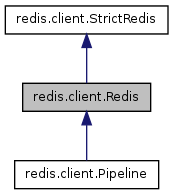
Public Member Functions | |
| def | lrem |
| def | pipeline |
| def | setex |
| def | zadd |
Static Public Attributes | |
| tuple | RESPONSE_CALLBACKS |
Provides backwards compatibility with older versions of redis-py that changed arguments to some commands to be more Pythonic, sane, or by accident.
| def redis.client.Redis.lrem | ( | self, | |
| name, | |||
| value, | |||
num = 0 |
|||
| ) |
Remove the first ``num`` occurrences of elements equal to ``value``
from the list stored at ``name``.
The ``num`` argument influences the operation in the following ways:
num > 0: Remove elements equal to value moving from head to tail.
num < 0: Remove elements equal to value moving from tail to head.
num = 0: Remove all elements equal to value.
Reimplemented from redis.client.StrictRedis.
| def redis.client.Redis.pipeline | ( | self, | |
transaction = True, |
|||
shard_hint = None |
|||
| ) |
Return a new pipeline object that can queue multiple commands for later execution. ``transaction`` indicates whether all commands should be executed atomically. Apart from making a group of operations atomic, pipelines are useful for reducing the back-and-forth overhead between the client and server.
Reimplemented from redis.client.StrictRedis.
| def redis.client.Redis.setex | ( | self, | |
| name, | |||
| value, | |||
| time | |||
| ) |
Set the value of key ``name`` to ``value`` that expires in ``time`` seconds. ``time`` can be represented by an integer or a Python timedelta object.
Reimplemented from redis.client.StrictRedis.
| def redis.client.Redis.zadd | ( | self, | |
| name, | |||
| args, | |||
| kwargs | |||
| ) |
NOTE: The order of arguments differs from that of the official ZADD
command. For backwards compatability, this method accepts arguments
in the form of name1, score1, name2, score2, while the official Redis
documents expects score1, name1, score2, name2.
If you're looking to use the standard syntax, consider using the
StrictRedis class. See the API Reference section of the docs for more
information.
Set any number of element-name, score pairs to the key ``name``. Pairs
can be specified in two ways:
As *args, in the form of: name1, score1, name2, score2, ...
or as **kwargs, in the form of: name1=score1, name2=score2, ...
The following example would add four values to the 'my-key' key:
redis.zadd('my-key', 'name1', 1.1, 'name2', 2.2, name3=3.3, name4=4.4)
Reimplemented from redis.client.StrictRedis.
tuple redis::client.Redis::RESPONSE_CALLBACKS [static] |
dict_merge( StrictRedis.RESPONSE_CALLBACKS, { 'TTL': lambda r: r != -1 and r or None, } )
Reimplemented from redis.client.StrictRedis.